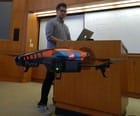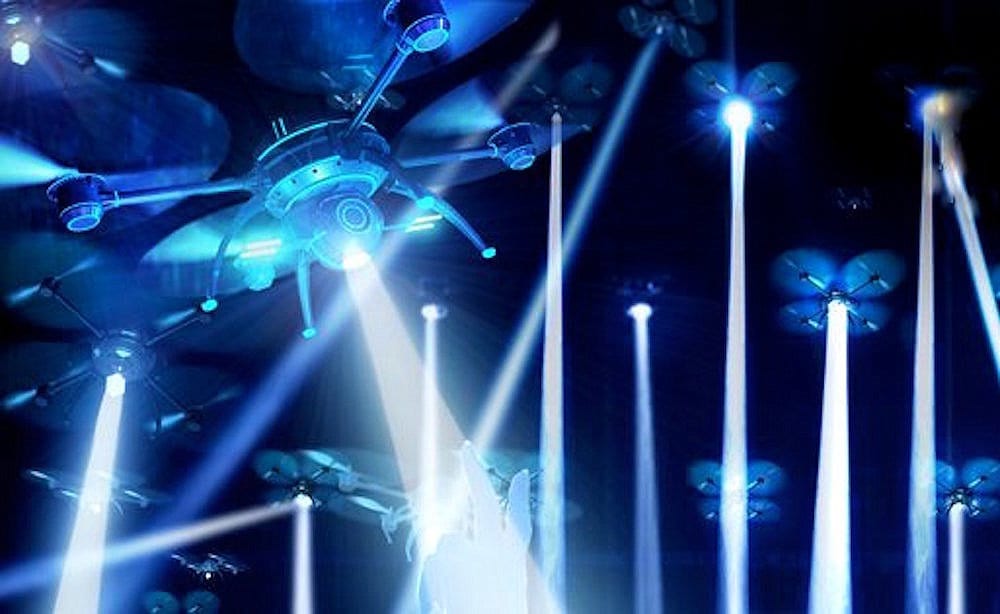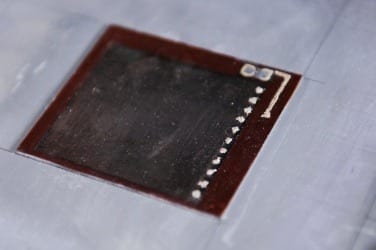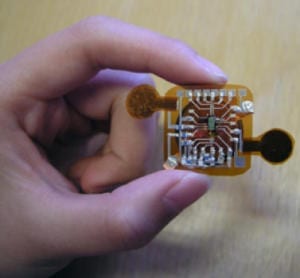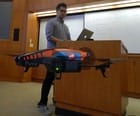
“We’re interested in the technical capabilities of drones, but also thinking through the socially good things that we can use drones for.”
Don’t be surprised if you hear a buzzing sound in the hallways of South Hall this semester; it’s the sound of the future, in the form of small student-piloted unmanned aerial vehicles, or drones.
This semester, a small team of School of Information students is experimenting with drones: becoming familiar with drones’ capabilities and imagining their future applications. The eight students, who call their group the “Drone Lab,” are working together in a South Hall classroom to develop open-source software for their drones and then testing them in the classroom, in the building’s atrium, and (occasionally) on the South Hall lawn.
“Drones have a pretty bad reputation,” admitted Dave Lester, a second-year MIMS student; when most people hear the word “drone,” they imagine high-tech killing machines or government surveillance. “We’re trying to do something a little different in Drone Lab,” said Lester, who was formerly the assistant director of the Maryland Institute for Technology in the Humanities at the University of Maryland. “We’re interested in the technical capabilities of drones, but also thinking through the socially good things that we can use drones for.”
“It’s a terrible, awful shame that many people only think of drones as flying objects that deliver weapons to targets,” said associate professor Coye Cheshire, Drone Lab’s faculty sponsor. “Just like airplanes, rockets, cars, and boats — you can tie a weapon on to any of those things, or you can do something interesting and maybe even helpful or good with them.”
Consumer-Grade Quadcopter
The students’ drones wouldn’t be capable of high-altitude surveillance, even if they were interested in it, since its range is limited to a couple hundred feet. The students are working with the Parrot AR.Drone 2.0, a consumer-grade drone priced at about $300 that’s a step above a model airplane, but many steps below military or civilian surveillance drones. The AR.Drone is a quadcopter — a small helicopter with four rotors — and it comes equipped with a high-definition 720p forward-facing camera, a downward-facing camera, an accelerometer, a gyroscope, a magnetometer, a pair of ultrasound altimeters, a rechargeable battery, and a 1GHz 32-bit processor running the Linux operating system. Parrot makes a few accessories, like a GPS sensor and a longer-lasting battery, and some hackers have figured out ways to attach additional devices, like environmental sensors.
Out of the box, the AR.Drone can be controlled by a smartphone app and piloted like a remote-controlled plane — but the real power is the ability to install your own software on the drone itself, allowing it to fly autonomously. When the students upload a specific set of instructions to the drone, it can fly off and perform specialized tasks on its own, reacting to what is sees and senses. “These are basically computers that can fly,” explained Lester.
The students started by installing node.js, a new software platform designed for building fast, scalable network applications in JavaScript, along with the node-ar-drone module. There is a growing community of developers writing and sharing open-source software modules for AR.drones; the I School Drone Lab is building on this foundation and sharing their own software modules with the community.
Not Droning On
Working with drones first-hand has sparked the students’ imaginations for the non-military possibilities presented by drones. For several of them, the starting point was the March 2012 “launch” of TacoCopter.com, a drone-based service that purported to deliver fresh tacos to patrons who had ordered from their GPS-enabled smartphone. Although TacoCopter turned out be a hoax, automated food delivery is really just the tip of the iceberg.
“Our students are finding new and innovative ways to use the devices to do interesting things,” said professor Cheshire. “For example, can you get a quadcopter to pick up and deliver objects on demand? Can you program the device to recognize hand gestures and other motions, and then respond in various ways?”
“There are lots of uses for drones that people may not typically think of when they hear the term,” said Lester. His teammate Elliot Nahman, also a second-year MIMS student, agreed. “I’m particularly interested in strapping sensors to it,” said Nahman. “Maybe you can use it in building science, to gather temperature profiles across a very tall space. Or there’s the potential for pollution monitoring: you can fly around the city and gather pollution data that would otherwise be difficult to collect.”
This week, India announced an effort to protect the rare one-horned rhino from poachers by using drones to patrol the borders of the vast Kaziranga National Park. In additon, a recent TIME Magazine article listed dozens of socially beneficial applications of drones:
“In Costa Rica they’re used to study volcanoes. In Japan drones dust crops and track schools of tuna; emergency workers used one to survey the damage at Fukushima…. Farmers are already using drones to monitor their crops; a weekly overhead picture of a field can give them the information they need to use less chemicals and water on the plants, saving money and the environment. Scientists use drones for wildlife conservation, mapping the nests of endangered species without disturbing them. And energy companies use drones to monitor electric pylons and gas pipelines.”
“So far the list of applicants for permission to fly drones [in the U.S.] consists mostly of universities, public agencies and drone manufacturers,” reports TIME Magazine. “According to its FAA application, Washington State’s department of transportation wants to try using drones for avalanche control. The U.S. Department of Energy plans to use a helicopter drone to take air samples. The Forest Service wants drones to help fight fires.” In addition, delivery companies like FedEx have been salivating for years over the possibility of employing drones.
Legal and Privacy Concerns
The spread of drones has raised a number of new regulatory and policy questions, led by widespread concerns about privacy.
The Latest Bing News on:
Drone Lab
- Air Force's ULTRA Long-Endurance Glider-Like Drone Is Now Operating In The Middle Easton May 8, 2024 at 1:57 pm
The product of a long program to field a low-cost, long-endurance surveillance drone, ULTRA is now flying missions around the Persian Gulf.
- Kaspersky's Alleged Drone Tech Ties To Russia: Military and Political Implicationson May 8, 2024 at 5:39 am
The timeline traces back to 2018 when a team named ALB-search, participating in a drone technology competition, failed to win but later became integral to Albatross’s establishm ...
- How drone EL mapping can help solar insurance claimson May 7, 2024 at 5:00 am
As the world becomes increasingly roiled by extreme weather, drone-based electroluminescence (EL) mapping can be a key weapon in the arsenal of solar investors.
- IDF Killing Palestinians with Sniper Drones Playing Recordings of Crying Infants?on April 30, 2024 at 10:12 am
In late April 2024, the claim emerged that the Israeli Defense Forces have used armed quadcopter drones against residents of Gaza's Al Nuseirat refugee camp to shoot and kill would-be good Samaritan ...
- The Air Force’s Combat Drone Saga Has Taken a Dramatic Turnon April 30, 2024 at 8:00 am
General Atomics XQ-67A Off Board Sensing Station (OBSS) drone seen during its first flight on Feb. 28, 2024 after taking off from Gray Butte Airport in Palmdale, CA. This design appears to correspond ...
- TUM professor turns drones into dancers using ChatGPT, here’s howon April 30, 2024 at 4:35 am
Robotics researchers from TUM just used ChatGPT to program a swarm of drones to perform a choreography in the air.
- High-tech drone to deliver 1 billion baby 'super clams' to Indian River Lagoonon April 29, 2024 at 2:25 am
University of Florida researchers and conservationists will use a drone to spread a billion clams in the Indian River Lagoon.
- AlabugaLeaks. Part 2: Kaspersky Lab and neural networks for Russian military droneson April 28, 2024 at 9:49 pm
A drone with a neural network is not the only collaboration project of Kaspersky with Albatross. The presentation of the combat version of the Albatross M5 UAV obtained by Cyber Resistance hacktivists ...
- Calgary lab utilizes drones to better understand wildfireson April 28, 2024 at 11:37 am
As wildfires begin to threaten Alberta communities, a cutting-edge lab in Calgary is hoping drones may help researchers better understand these devastating blazes.
- Ukraine alleges Russia is planning drone training classes for school kids in occupied regionson April 28, 2024 at 7:45 am
Russia plans to introduce drone training sessions, covering design features and assembly, in schools in occupied parts of Ukraine, report says.
The Latest Google Headlines on:
Drone Lab
[google_news title=”” keyword=”Drone Lab” num_posts=”10″ blurb_length=”0″ show_thumb=”left”] [/vc_column_text]The Latest Bing News on:
Drone applications
- NATO Enhances Drone Surveillance Amid Intensified Demand for Actionable Intelligenceon May 8, 2024 at 10:24 pm
As the geopolitical landscape continues to evolve with increasing tensions and conflicts, notably the ongoing Russia-Ukraine war, NATO has significantly stepped up its drone surveillance operations to ...
- Controversial drone company Xtend leans into defense with new $40 million roundon May 8, 2024 at 6:00 am
But the company leans heavily into military, defense and law enforcement applications. Xtend has contracts with the Israel Defense Forces (IDF) and the U.S. Department of Defense to “develop and ...
- UAV (Drone) Market worth $48.5 billion by 2029 - Exclusive Report by MarketsandMarkets™on May 8, 2024 at 4:19 am
The UAV (Drone) market is estimated to be USD 30.2 billion in 2024 and is projected to reach USD 48.5 billion by 2029, at a CAGR of 9.9% from ...
- Controversial drone company Xtend leans into defense with new $40M roundon May 8, 2024 at 2:01 am
"Our platform empowers drones and robots to handle specific tasks autonomously ... But the company leans heavily into military, defense and law enforcement applications.
- La Jolla News Nuggets: Drone show, app goes live, ‘Ballad of Johnny and June,’ moreon May 7, 2024 at 4:00 pm
If the community truly supports this event and wants it to happen in future years, contributing to the foundation’s drone show fund will make it possible to keep the tradition alive.” Businesses and ...
- Sullivan: Has tagging met its match with WSDOT’s ‘graffiti-battling’ drone?on May 7, 2024 at 6:14 am
Taggers, you are on notice. The state of Washington is coming after you with a high-tech gadget: The world's first graffiti-battling drone.
- Drone Express gains FAA acceptance of applicationon May 6, 2024 at 4:59 pm
Drone Express, which plans to provide drone delivery services in Winston-Salem, said Monday the Federal Aviation Administration has accepted its Part 135 application. The goal is becoming a fully ...
- This Drone Company's Acquisition Offers Valuable Lessons on When to Sell Your Businesson May 6, 2024 at 10:03 am
Robinson Helicopter's deal with Ascent AeroSystems proves uplifting synergies can be found in unexpected places. Here's how the deal went down.
- Drone Express Part 135 Application Accepted by FAA, Paving the Way for BVLOS (Beyond Line of Sight) Delivery Operationson May 6, 2024 at 8:27 am
Drone Express, a leading innovator in autonomous delivery solutions, is proud to announce that it's Part 135 Application has been accepted by the FAA. This milestone in the certification process ...
- This genius ‘vampire drone’ is designed to fly foreveron May 6, 2024 at 2:30 am
The drones feed on electricity from power lines to ensure they can keep flying. Engineers from the University of Southern Denmark have developed an ingenious technology that enables a drone to fly ...
The Latest Google Headlines on:
Drone applications
[google_news title=”” keyword=”drone applications” num_posts=”10″ blurb_length=”0″ show_thumb=”left”]







